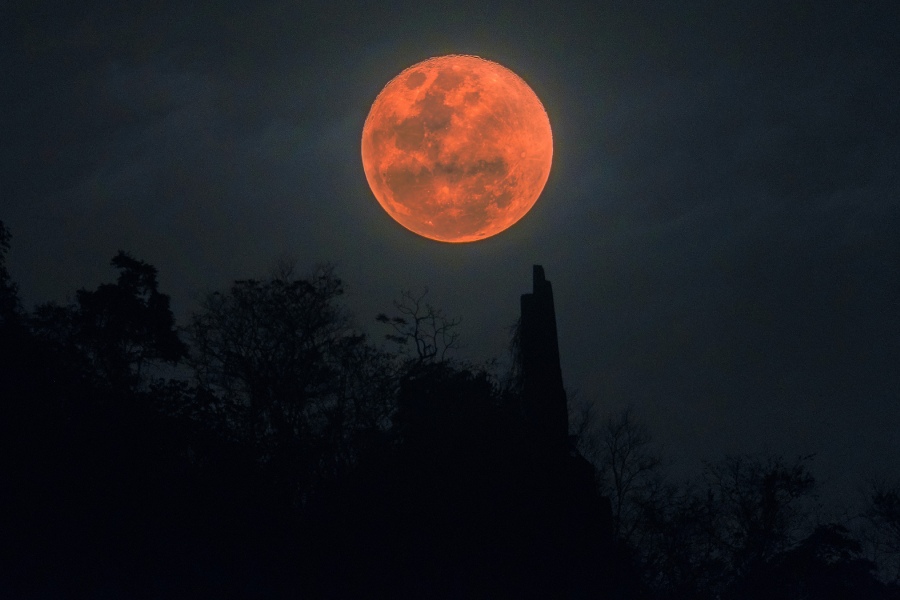Picture the Moon as Earth’s celestial companion, a radiant orb that graces our night skies. Now, imagine a solar eclipse as a cosmic rendezvous – a moment when the Moon steps between Earth and the Sun, creating a celestial spectacle. But why does the Moon turn red during a lunar eclipse?
Let’s find out why lunar eclipses occur. We’ll discuss how Earth’s atmosphere influences sunlight during an eclipse, turning the Moon red. We’ll explore how light wavelengths and our atmosphere work together to create this colorful sky effect. Lastly, we’ll check out the conditions for the most captivating blood-red eclipses.

Why Does the Moon Turn Red During a Lunar Eclipse?
During a lunar eclipse, the Moon turns red due to a phenomenon known as the “Red Moon Effect“. This occurs when the Earth comes between the Sun and the Moon, casting a shadow on the Moon.
However, instead of the Moon disappearing completely, it often takes on a reddish hue. This happens because of the way Earth’s atmosphere bends and filters sunlight, allowing longer wavelength colors like red to pass through while shorter wavelength colors are scattered away.
As a result, the light that reaches the Moon during a lunar eclipse is predominantly red. This gives its characteristic reddish coloration.
The Moon turning red during a lunar eclipse is an intriguing phenomenon. To understand why this occurs, we need to explore the red Moon effect and the color spectrum of light.
Understanding the color spectrum of light
Light’s color is determined by its wavelength. Shorter wavelengths look blue or violet, and longer ones look red. And sunlight has all the visible light wavelengths.
During an eclipse, the atmosphere filters sunlight, letting certain wavelengths through. Earth’s atmosphere scatters shorter wavelength light, taking away green, blue, indigo, and violet. Yet, longer wavelength red light makes it through.
Rayleigh scattering and its Impact
Selective scattering happens because of Rayleigh scattering. This process explains that shorter wavelengths get scattered more by air molecules and particles. The Moon looks red during a total lunar eclipse because the noticeable red wavelengths bounce off its surface.
Rayleigh scattering really changes how the Moon looks in an eclipse. The Moon takes on a unique crimson color when shorter wavelengths scatter and longer red wavelengths pass through. That’s why we see the “Blood Moon” with its reddish hue.
What Causes the Moon to Change Color?
The Moon changing color during a lunar eclipse is an enchanting phenomenon. But what causes this captivating transformation? To unravel the science behind it, we need to explore how light interacts with Earth’s atmosphere.
The science behind this captivating transformation
So, why is the lunar eclipse red? During an eclipse, sunlight goes through various optical processes in Earth’s atmosphere. These processes are refraction, diffraction, and scattering.
Refraction happens when light waves bend while passing through different-density materials. Diffraction is when light waves spread out and bend around obstacles. Scattering occurs when light waves change direction randomly after interacting with particles.
All these interactions change sunlight before it reaches the Moon’s surface. Blue and violet light with shorter wavelengths gets scattered away, while longer wavelengths like red and orange remain, giving the Moon a reddish glow.
Variations in Lunar Eclipse Colors
The red color during a lunar eclipse can change because of two things. One is the air around Earth and how clear it is. If the air is clear, more sunlight can get through, making the red color deeper and brighter. But if there are clouds, they block and spread the light, making the red color darker and less bright.
The second thing is the stuff in the air, like dust and pollution. More of this stuff means there are more things for sunlight to bounce off, making the Moon look lighter and more orange. Less stuff in the air means the Moon will look a darker red.
Examples of different lunar eclipse colors
The lunar eclipse of December 2011 produced a remarkably deep blood-red Moon visible from parts of Europe, Asia, Africa, and Australia. Clear skies allowed unobstructed sunlight to pass through Earth’s atmosphere, casting an eerie crimson glow on the Moon.
By contrast, the lunar eclipse of January 2019 had a much duller, brownish-red tone as seen from North and South America. Dust storms and wildfire smoke particles in the atmosphere scattered more of the sunlight, reducing the deep red hues.
These examples demonstrate how variable atmospheric conditions can make each lunar eclipse unique in terms of the Moon’s coloration.
Conclusion
Why does the Moon turn red during a lunar eclipse? The Moon takes on a red hue during a total lunar eclipse due to the fascinating interactions of light waves with Earth’s atmosphere.
When sunlight passes through our atmosphere, shorter wavelength blue and violet light is scattered away by particles in the air. The longer wavelength red light persists, cascading onto the lunar surface and giving the Moon its characteristic crimson color.
By comprehending the principles of light scattering and refraction, one can now fully appreciate this mesmerizing celestial wonder when it next graces the skies. The next time an observer witnesses the lone satellite bathed in an eerie red glow, they will comprehend the atmospheric factors giving rise to its stunning transformation.
